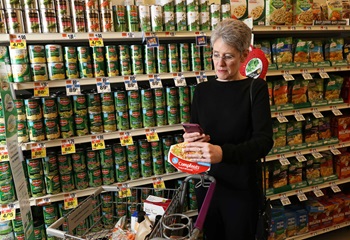Five Questions Shoppers Ask About The Food They Buy
Jul 09, 2018
By: David Fikes, Vice President, Consumer/Communication Affairs and Communications, Food Marketing Institute
 The equation of what it means to eat well is different for every consumer. For a few it remains a simple calculation of cost of the product plus the convenience of serving it. However, according FMI’s U.S. Grocery Shopper Trends 2018, the eat-well equation for most shoppers today involves a complex consideration of numerous factors including the ethics of production methods, environmental impact of the package and its contents, nutritional value of the food and sense of taste discovery.
The equation of what it means to eat well is different for every consumer. For a few it remains a simple calculation of cost of the product plus the convenience of serving it. However, according FMI’s U.S. Grocery Shopper Trends 2018, the eat-well equation for most shoppers today involves a complex consideration of numerous factors including the ethics of production methods, environmental impact of the package and its contents, nutritional value of the food and sense of taste discovery. Without a doubt the consumer QPI (question per item) has significantly increased over the last decade. Consumers have a strong desire to know what’s in their food, beverages, and everyday household items. They are curious about how the product is made, if it is environmentally friendly, and if it’s healthy in both the short term and in the long run. And in the quagmire of their questions, shoppers are in quest of reliable sources for the answers to help them find trusted, accurate answers.
Technology and digital services can offer a viable solution to the information-hungry customer by providing access to the targeted information they want in the way they prefer to consume it. It’s also a way for grocers to provide transparent information that can be configured according to shoppers’ questions in a convenient, quick, easy and satisfying way.
That’s why nearly 28,000 products already utilize digital disclosure methods such as SmartLabel™. This tool allows food retailers and their customers to quickly and easily find out nutritional information, ingredients, allergens, third-party certifications, social compliance programs, usage instructions and advisories, as well as safe handling instructions, company/ brand information and much more.
Here are five quick examples of the kinds of questions shoppers may ask about the products in your stores that can be found on SmartLabel:
Allergy SensitivityHow is a candy bar made and were almonds used on other lines in the factory? Shoppers with an allergen-sensitive family can use SmartLabel’s searchable database to find this information at www.smartlabel.org.
Environmental StewardshipWhere was this air freshener sourced? Learn more at SmartLabel.
CertificationsWhat does this certification symbol mean on this package? Check SmartLabel to learn more about product partnership with eco-friendly organizations.
IngredientsWhat is Dicalcium Phosphate Dihydrate and why is it in toothpaste? The information isn’t explicitly included on the label, but SmartLabel has the explanation for this ingredient that helps clean and polish teeth.
“Free From” InformationDoes gelato contain artificial colors or flavors? If this impacts a shopper’s purchase decision, find the details at SmartLabel.
SmartLabel information is available anytime and anywhere — while making a shopping list at home or in the grocery aisles. Detailed information is available by scanning a QR or digital code on the package, using a Web search, going to the company’s website, calling a 1-800 number on the package, visiting SmartLabel.org or downloading the free SmartLabel app.
No comments:
Post a Comment